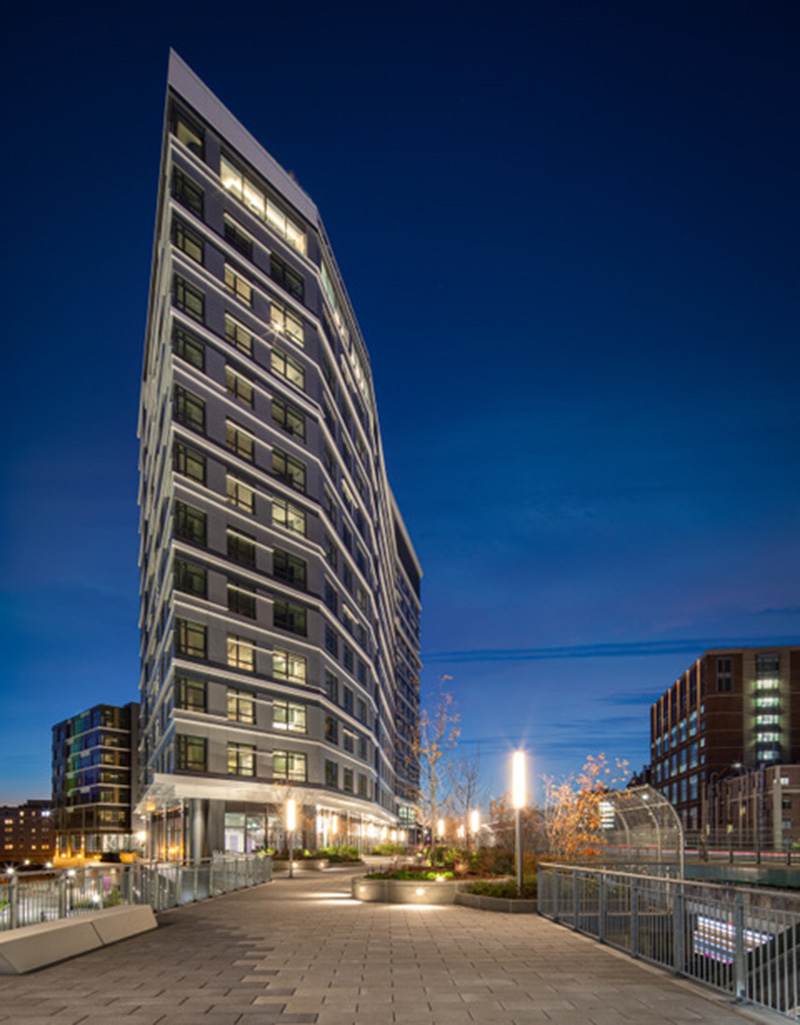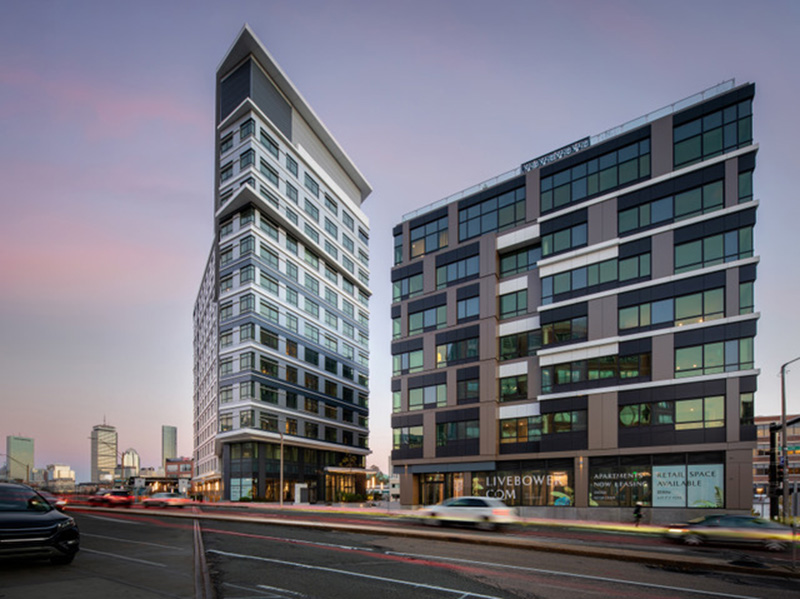The Architectural Team completes new mixed-use building - Bower

Boston, MA Reflecting its creative approach to urban placemaking, the architecture, planning, and interior design firm The Architectural Team (TAT), has completed Bower, a mixed-use infill complex transforming the area around Boston’s historic Fenway Park into a connected, walkable, and vibrant neighborhood with new rental housing and retail offerings, transit access, and public space.
As the first phase of the highly anticipated transit-oriented Fenway Center development, Bower offers 312 residential units and 40,000 s/f of commercial space across two buildings. Community resources including a 12,500 s/f, multilevel pedestrian plaza offer vital connections between the growing Fenway, Kenmore, and Longwood Medical Area neighborhoods, helping the districts cohere seamlessly and easing access to commuter rail services at an adjacent transit hub.
Planned and designed by TAT for Fenway Center Development LLC –a joint venture of The Green Cities Company, Meredith Management, and Nuveen – Bower is notable for its market-leading focus on resident health and wellbeing. Certified LEED Gold and pursuing a Fitwel certification, which evaluates a design’s positive impact on user health and wellness, the project sets a new standard for residential development in New England with thoughtful amenities, innovative material choices including dynamic glazing that adjusts to ambient light conditions, and compelling biophilic interiors by Planeta Design Group.
Bower also builds on TAT’s longstanding legacy of planning and design initiatives that directly benefit communities. The firm, honoring its 50th anniversary in 2021, is widely known for transformative works like Bower that help regenerate neighborhoods and catalyze new investment. Examples include iconic Boston places such as the Baker Chocolate Factory complex in Dorchester, the Clippership Wharf mixed-use infill waterfront development in East Boston, and scores of reimagined historic mills, schools, hospitals and commercial buildings now providing housing in cities and towns nationwide. In demonstrating the potential of large-scale developments to enhance urban livability, TAT leadership believes Bower represents one of the firm’s most impactful undertakings to date.
“Bower stands among the most significant infill developments Boston has seen in a generation, and it is a valuable example for other cities and sites where tangible quality-of-life benefits to residents and the public at large are the crux of improving their urban experience,” said Jay Szymanski, AIA, NCARB, LEED AP, a principal at TAT and a frequently cited expert on multifamily housing and neighborhood revitalization. “Sitting at a major urban crossroads, and involving a partnership of several of the nation’s most talented and dedicated developers, this is truly a lifetime project for the entire team.”
“Our design goal was to connect people to nature and use it as a gateway to rejuvenating our health and well-being,” said Patrick Planeta, principal of Planeta Design Group. “The design team used an array of natural materials, fluid forms and reflective elements to enhance the feeling of bringing the outdoors inside. This design approach was also informed by evolutionary psychology that offers clues to understanding automatic responses triggered by our modern, man-made surroundings.”

According to Kelly Saito, managing partner of Green Cities Company, “Bower is indicative of our pledge in real estate management and investment to ensure a holistic approach through our key performing index of environmental impact, resiliency, climate change mitigation, diversity and inclusivity, as well as key health and wellbeing benefits to drive a shared prosperity between owners, investors, and residents.”
Working in tandem to define the irregularly shaped site, Bower’s two buildings–one at eight stories and the second at 14–offer a striking and highly visible new presence in the city. The smaller structure, Tower 1, mirrors its mid-rise surroundings with a strongly gridded and textured façade whose moody colors and window patterns recall the area’s industrial heritage. Set above an airy retail podium, its taller counterpart, the long and thin Tower 2, presents a dynamic, faceted appearance that seems to shift in form and weight, tapering to sharp points at either end. To Bostonians and others familiar with this location butting up against the Massachusetts Turnpike, the composition offers a striking transformation.
Built on what was previously a series of parking lots and underutilized, state- and city-owned land, Bower helps fill a longstanding gap in Boston’s urban network created by highway construction in the 1960s. TAT’s design reknits this fabric through a combination of clever massing of the two Bower structures -- which rise in height and scale from historic Beacon Street to the highway–and the creation of the new public plaza whose meandering paths link the buildings and provide, for the first time, a fully accessible pedestrian connection from Beacon Street 23 feet down to David Ortiz Drive and Fenway Park below.
Built on a landscaped deck over regional rail lines and platforms, the plaza also offers new stair and elevator access to that train service, directly tying the surrounding streets to both levels of the renovated and expanded Landsdowne Station –a boon for ballgame goers, commuters, and especially those with mobility challenges. As the centerpiece of the larger Fenway Center project, TAT’s design for this public amenity also reflects the culmination of a decades-long initiative to expand transit access at this long-underutilized but ideally located site where development plans first came into focus more than 25 years ago.
According to the architects, realizing the Bower project meant overcoming significant design challenges resulting from the complex mix of infrastructural uses at the site –- a set of technical hurdles and solutions ranging from the need to build around a municipal gas line just 18 inches away from the buildings’ foundation walls, to the relocation of a water line, and the use of extensive temporary bracing to support the foundation itself as it was poured. The successful navigation of these challenges reflects the outcome of innovative design solutions and close collaboration and coordination between a diverse array of private entities and public officials and agencies, in what local sources see as a case study in effective public/private partnerships utilizing state land.
“For most of my career, this was an inhospitable and inaccessible area for pedestrians,” said TAT’s Szymanski. “Reaching Beacon Street from Ortiz Drive meant trekking up a hill and across multiple parking lots. Now, Bower is also a place to be as much as a place to move through. Building a positive, uplifting environment here is a real urban design success story, and it took a lot of creative problem solving. This was a technically challenging project: Sandwiched between Beacon Street, the train line, and a myriad of existing infrastructure elements, our team had to thread the needle to fit two buildings and a plaza onto this plot of land which had no right angles.”
Nobis Group awards Robinson and Moreira STEM scholarships

The design-build advantage: Integrated interior design solutions - by Parker Snyder

The rise of incubators and co-working spaces: The latest in life sciences - by Matt Combs

Careers in Construction Month focus on training and safety - by Joe Camilo









